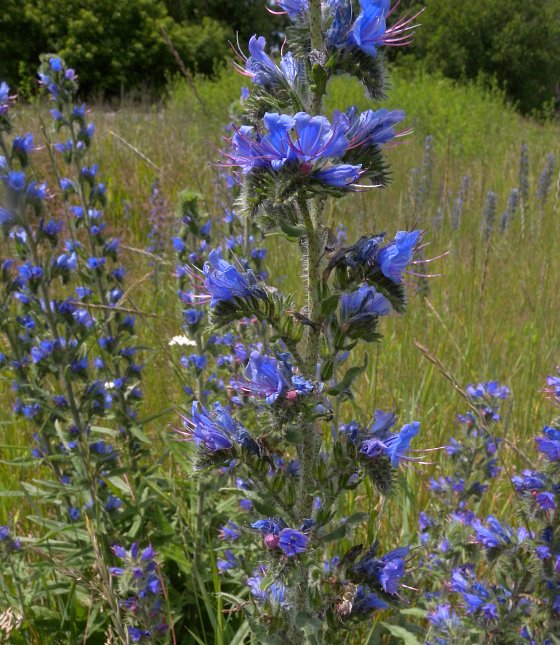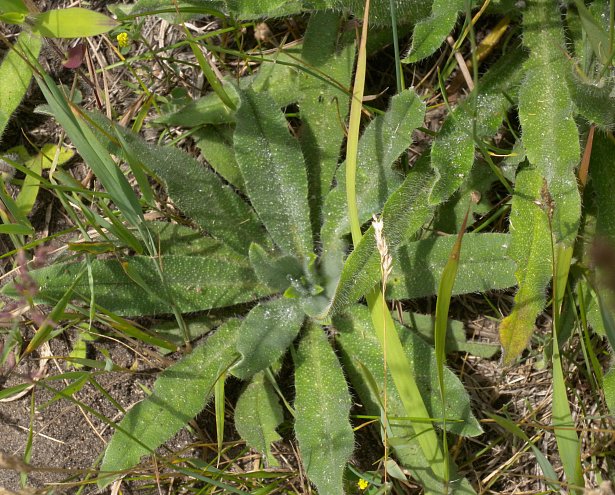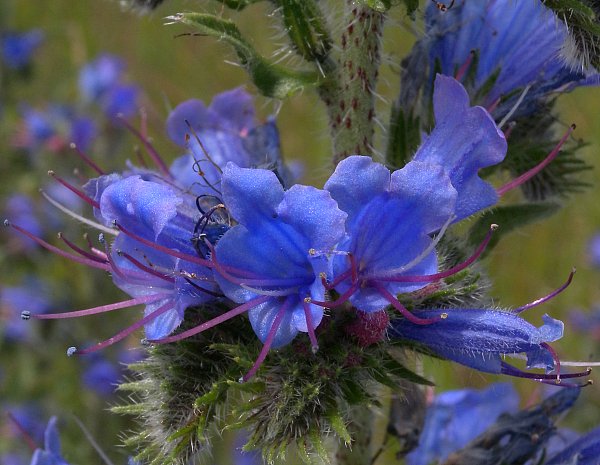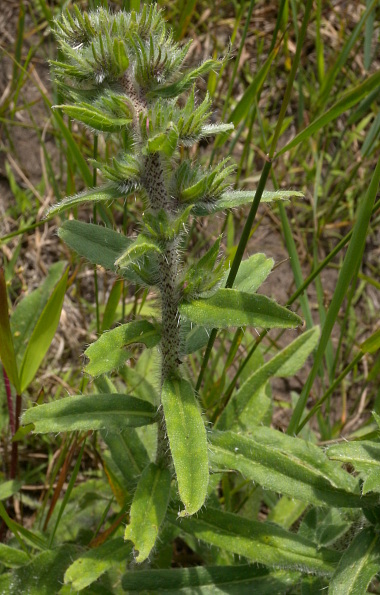
The stems terminate in inflorescences that are ½–2' long; they consist of spike-like racemes of short scorpioid cymes. The cymes are incurled like a scorpion's tail, and they contain up to 20 flowers each; the sessile flowers are arranged along only one side of the cyme. Each flower is about ¾" across and 1" long, consisting of a deep blue or blue-violet corolla with 5 shallow lobes, 5 grayish green sepals, 5 stamens with reddish purple filaments, a slender white style with a divided tip, and a 4-lobed ovary. The large corolla is campanulate (bell-shaped), but longer above than below. The sepals are grayish green, linear-oblong in shape, and covered with stiff bristly hairs. Both the stamens and style are strongly exserted from the corolla. At the base of each cyme, there is a linear-lanceolate leafy bract up to 1" long that is grayish green and covered with stiff bristly hairs. The central stalk of the inflorescence has the same characteristics as the central stem. The blooming period occurs during the summer and early autumn, lasting 1-3 months. Afterwards, each flower is replaced by up to 4 nutlets (usually only 1-2 nutlets are produced). The nutlets are about 2.5 mm. long, grayish brown, angular-ovoid in shape, and tuberculate (minutely bumpy). The root system consists of a black taproot that extends up to 2½' into the ground. This plant reproduces by reseeding itself.

Cultivation: The preference is full sun, dry-mesic to dry conditions, and barren soil containing limestone gravel or calcareous sand. Hot dry weather is readily tolerated.
Range & Habitat: Viper's Bugloss is occasional in NE Illinois, uncommon in east-central Illinois, and rare or absent in other parts of the state (see Distribution Map). It was introduced into North America either accidentally as a weed, or it may have been introduced deliberately as a horticultural plant because of the showy flowers. Viper's Bugloss is native to the Mediterranean area of Europe, and possibly neighboring areas of Asia. Habitats include gravelly or sandy areas along railroads, gravelly or sandy roadsides, old abandoned fields, pastures, and waste areas. Open barren areas with a history of disturbance are preferred.

Faunal Associations: The nectar and pollen of the flowers attract honeybees, bumblebees, mason bees, and Halictid bees. A mason bee, Hoplitis anthocopoides, is a specialist pollinator of Viper's Bugloss (Echium vulgare). In addition to these floral visitors, the Ruby-throated Hummingbird and butterflies occasionally visit the flowers for nectar (Klemow et al., 2002). Other insects feed destructively on the flowers and other parts of this plant. These species include a flea beetle (Longitarsis melanurus), a plant bug (Plagiognathus politus), a lace bug (Dictyla echii), the Thistle Aphid (Brachycaudus cardui), and larvae of the Viper's Bugloss Moth (Ethmiia bipunctella); see Clark et al. (2004), Wheeler et al. (1983), Marshall (2006), and Blackman & Eastop (2013). Because the foliage is heavily armed with piercing bristly hairs and it contains toxic pyrrolizidine alkaloids, this plant is avoided by mammalian herbivores, making it an 'increaser' in overgrazed pastures. It is possible that the seeds are distributed by mammalian herbivores to some extent because the bristly calyces containing the seeds can become detached from the plant and cling to their fur. However, most seeds fall to the ground not far from their mother plants (Klemow et al., 2002).

Photographic Location: A sandy area near a railroad outside of Illinois Beach State Park in NE Illinois.
Comments: Because of its large showy flowers and exceptionally bristly foliage, this is a very distinctive and striking plant that can't be confused with anything else. The common name of this plant derives from its use as a treatment for snakebites. Another common name for it is Blueweed. While Viper's Bugloss (Echium vulgare) is considered a good honey plant by beekeepers, its honey may be mildly toxic from pyrrolizidine alkaloids. These alkaloids over time can damage the liver (Klemow et al., 2002).